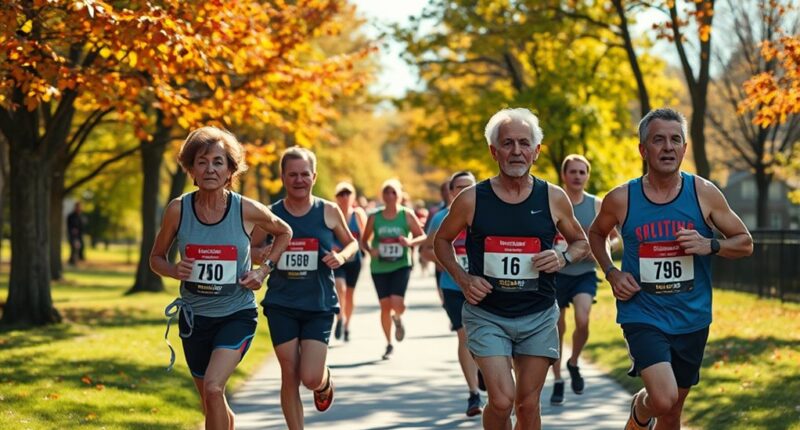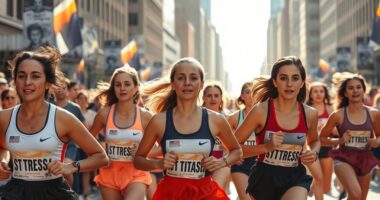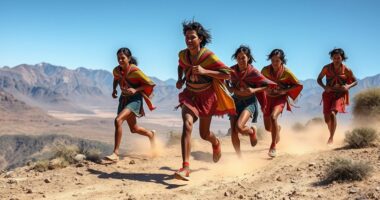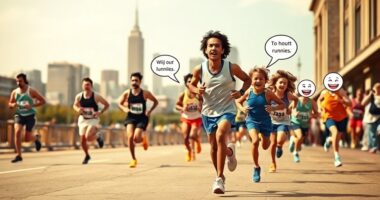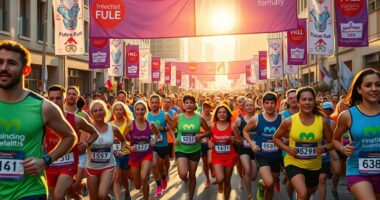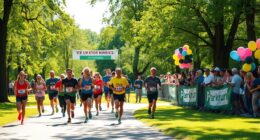The growth of age-group competition in masters running is fueled by advances in training, community support, and focus on lifelong health. Many runners over 40 and beyond now benefit from personalized training, injury prevention, and new recovery methods. Local races, clubs, and online forums foster camaraderie and motivation, encouraging continued participation. As more older athletes challenge personal records and enjoy the sport, you’ll discover how these trends keep pushing possibilities further—if you want to explore what’s behind this rise, keep going.
Key Takeaways
- Advances in training and recovery methods enable older runners to maintain competitive performance levels.
- Community engagement through clubs and events fosters motivation and sustained participation among age-group athletes.
- Age-group awards and organized races recognize achievements, encouraging continued involvement in masters running.
- Innovative programs promote health, safety, and personalized training, expanding opportunities for older athletes to compete.
- The growth of masters running reflects a shift toward redefining athletic achievement at any age.

Have you ever wondered how runners over a certain age continue to push their limits and compete at high levels? It’s inspiring to see older athletes not only maintaining their fitness but also thriving in competitive environments. One key reason is the rapid progress in training advancements tailored specifically for masters runners. Coaches and sports scientists are developing smarter training protocols that emphasize recovery, injury prevention, and individualized workout plans. These innovations help you maximize your performance without risking burnout or injury, which is especially important as you age. Techniques like interval training, strength conditioning, and flexibility routines are now integrated into regular training, allowing you to build endurance and speed more effectively. Furthermore, advances in sports nutrition and recovery methods enable you to optimize your efforts, recover quicker, and sustain a high level of performance over the years. The evolution of training protocols has made it easier than ever for older runners to stay competitive and healthy.
Community engagement plays a crucial role in the growth of masters running. It’s no longer just about individual achievement but also about belonging to a supportive network of like-minded athletes. Running clubs, local races, and online forums create environments where you can share experiences, exchange advice, and celebrate milestones. This sense of camaraderie fuels motivation and keeps you committed to your goals. When you see other runners your age pushing their boundaries, it becomes easier to stay disciplined and inspired. Community events often feature age-group awards, which recognize your efforts and help you set tangible goals. These gatherings foster a spirit of friendly competition while emphasizing health, enjoyment, and personal progress.
The combination of training advancements and community engagement has democratized masters running. No matter your age, you now have access to resources that help you improve safely and effectively. You can participate in organized races, join running groups, or simply connect with fellow enthusiasts online. This support system encourages continuous improvement and makes the journey more enjoyable. As a result, more runners over 40, 50, 60, and beyond are discovering that they can still challenge themselves, set personal records, and experience the thrill of competition. Masters running isn’t just about staying active; it’s about redefining what’s possible at any age. Through ongoing innovations in training and a strong sense of community, you’re empowered to keep moving forward, embracing new challenges, and celebrating every stride along the way.
Frequently Asked Questions
How Do Age-Group Rankings Influence Race Strategies?
Age-group rankings influence your race strategies by encouraging strategic planning and smart race pacing. Knowing where you stand can motivate you to push harder or conserve energy, depending on your goals. You might accelerate in the final miles or maintain a steady pace to maximize your ranking. Ultimately, understanding your position helps you tailor your effort, ensuring you race efficiently and confidently, aiming for personal bests or top spots.
What Are Common Training Adaptations for Older Runners?
Imagine you’ve adjusted your training to include more cross-training and strength work, just like many older runners do. These training adjustments help prevent injuries and improve longevity. You might incorporate low-impact activities like swimming or cycling, which boost endurance without stressing your joints. Consistent flexibility and balance exercises also become key for injury prevention, ensuring you stay healthy and able to enjoy running well into your later years.
How Has Technology Impacted Masters Running Performance?
Technology advancements have considerably improved your masters running performance by providing better training tools and data analysis. Wearable devices track your pace, heart rate, and recovery, helping you optimize workouts and prevent injuries. Smart footwear and injury prevention technologies also support your joints and muscles, reducing the risk of setbacks. Overall, these innovations empower you to train smarter, stay healthier, and enhance your age-group performance efficiently.
What Psychological Benefits Do Older Runners Experience?
Imagine crossing the finish line feeling unstoppable—that’s the mental resilience you gain from running. Older runners often experience improved mood and self-esteem through community support, which boosts their psychological well-being. You find purpose and motivation in training, reducing stress and fostering a sense of achievement. This sense of belonging and personal growth helps you stay mentally sharp, confident, and resilient, making running a powerful tool for emotional health at any age.
Are There Specific Nutrition Guidelines for Masters Athletes?
You should follow specific nutrition guidelines tailored for masters athletes, focusing on nutritional timing to maximize energy and recovery. Prioritize hydration strategies before, during, and after exercise to prevent dehydration and maintain performance. Incorporate a balanced diet rich in carbohydrates, protein, and healthy fats, and consider electrolyte intake for longer runs. These practices help support your aging body’s needs, enhance recovery, and sustain your running goals effectively.
Conclusion
As you lace up and hit the pavement, remember that age is just a number in this vibrant tapestry of runners. Masters running blooms like a resilient garden, where every stride blossoms with experience and passion. No matter your age, you’re writing a story of perseverance and grit, turning the road into a canvas of endless possibility. So keep moving forward—your journey is a masterpiece in the making, painted with determination and heart.
